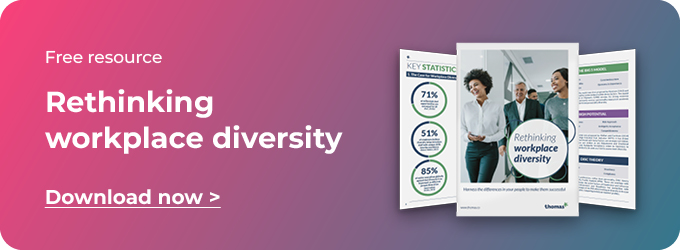What used to be a buzzword in the workplace is now anything but. Diversity is a major recruitment tool, helping businesses to grow in many different ways. This is backed up by a survey conducted by recruitment specialists, Glassdoor which showed that 67% of active and passive job seekers consider diversity when considering job offers and employers.
With over 3 million citizens identifying themselves as non-UK-born working in the UK (according to 2019 census), diversity in the workplace is more common than what might be expected.
The benefits of cultural diversity in the workplace are clear for both the employer and wider society. Many studies have shown that it creates an environment where there is greater innovation, better problem solving and better overall customer service among many other things - we will explore these later on.
This guide will cover what diversity is in the workplace, why it is beneficial, what diversity management involves, strategies for managing diversity in the workplace and what diversity training looks like.
What is diversity in the workplace?
A broad definition of diversity in the workplace is that a company will hire a wide range of diverse people with diverse characteristics.
However, whilst diversity is often considered to relate primarily to multiculturalism, diversity can include; age, gender, race, sexual orientation, education, background, languages and abilities. With this definition you can start to understand a wider perspective of diversity in the workplace and how by embracing these different elements you can create a better, more inclusive and tolerant workforce.
It needs to be also noted that workplace diversity isn’t constrained to a hiring policy. It’s also about participation. That means, you are not going to be hiring diverse groups without giving them a voice in areas which they can influence. Participation is about giving responsibility to these groups and giving them an equal voice to help share ideas and create the conditions to make the workforce and business a better place.

8 reasons why diversity is beneficial
Improving workplace diversity and inclusion has been shown to create a positive environment where there is greater innovation, better problem solving and better overall customer service. There are many more factors that need to be taken into consideration, we are going to look at some and expand on why diversity is beneficial in the workplace.
1. Diverse perspectives
As previously described, diversity brings about a wide variety of diverse perspectives, but what that truly means is that diversity will show the different characteristics and backgrounds of each individual. This means that they bring a variety of different skills and experiences.
In return, a more diverse workforce will have a wider variety of perspectives which is extremely beneficial when it comes to planning and executing a business strategy.
2. Boosted creativity
The more views and perspectives you have, the greater the exposure to increased creativity from the workforce.
Think of it this way, when you put together a group of people who are from the same background and see things the same way, very little will challenge their thoughts and perspectives. But, add in someone who has seen different things all together, you are going to get fresh, new ideas and in return, improve the creativity and productivity of your workforce.
3. Greater innovation
According to Josh Bersin’s research, inclusive companies are 1.7 times more likely to be innovation leaders in their market.
The more diversity the more employees are exposed to new perspectives and worldviews. Combining these views can often lead to greater innovation.
4. Improved decision making
Again, bringing together different views, experiences and ultimately, knowledge will help workforces make better decisions.
Researchers have found that when diverse teams made a business decision, they outperformed individual decision-makers up to 87% of the time.
5. Increased productivity
Again, the more we can create a diverse workforce that focuses on talent, skills and abilities, the more positive impact that it will have on productivity.
6. Maximise profits
This has been studied extensively over the years and the data is impressive to say the least. One of the latest reports from the consulting group, McKinsey, titled ‘Diversity Wins’, has highlighted the financial risk businesses take when they ignore diversity at the top. Their research has found that companies with the most ethnically diverse boards outperformed those with the least diverse boards by 36%.
Other research points to the cash flows of diverse companies which are 2.3 times higher than those of companies with more monolithic staff. Diverse companies are 70% more likely to capture new markets than organisations that do not actively recruit and support talent from under-represented groups.
7. Reduced employee churn
It makes sense that companies who have a more diverse workforce are generally more inclusive of different individual characteristics and perspectives.
This leads to greater inclusion which means that employees feel more accepted and valued, and that they’re also happier because of this. The more diverse the workplace, the lower the turnover rates.
8. Higher employee engagement
As with reduced turnover, the principals of engagement remain very similar. With more people having the shared knowledge and experiences of feeling like they may not traditionally fit into the workplace, the more diverse the teams, the less this is an issue.
However, when participating at a higher level, when feeling more included in the general direction of the business, there is more to be positive about. As highlighted in a study carried out by Deloitte which captured the experiences of 1,550 employees in three large Australian businesses operating in manufacturing, retail and healthcare. This research showed that engagement is an outcome of diversity and inclusion.
What does diversity management involve?
Diversity management is primarily focused in two specific areas, diversity and inclusion. Understanding this helps to focus your approach to diversity management.
In the past, diversity management used to be primarily focused on avoiding discrimination in recruitment. However, better selection processes and psychometric assessments are addressing unconscious bias in the selection process.
Instead, what we are seeing is an increased awareness of the importance of diversity in the workplace for many of the reasons stated previously. The positive advantages it brings coupled with the wider sense of diversity in the workplace offering better world perspectives and views.
In order to better manage diversity, many organisations have taken to creating and defining an equality and diversity policy. This is a document which is a written agreement by your business about how you will avoid discriminating against people, and how you will create a safe and inclusive atmosphere for your members and customers. This will help guide you to make better decisions about diversity and inclusion management.
Organisations will at the same time create an inclusive hiring plan. This is a roadmap which creates inclusive recruitment, a process of connecting with, interviewing, and hiring a diverse set of individuals through understanding and valuing different backgrounds and opinions.
Finally, diversity and inclusion training may be considered to help managers and individuals in the organisation understand more about this topic and why it is important to have a greater understanding of diversity in the workplace.

Strategies for managing diversity in the workplace
There are many different strategies for improving and managing diversity in the workplace. These include:
- Getting buy-in from management and the board
- Reviewing and revising the hiring policy
- Creating and defining inclusive policies and practices
- Conducting diversity training
- Dealing with unconscious bias
- Improving communication
- Introducing mentoring schemes
- Monitoring and addressing staff retention
- Building a diverse corporate structure
- Considering flexible working arrangements
- Developing room for individual expression within the workplace
What is diversity training?
Diversity training is better understood as ‘an initiative to create awareness about the diversity within the workforce and bring about cohesiveness in teams.’ In practice, it’s about giving people an opportunity to understand more about what diversity means, what it looks like in an organisation and to develop a better understanding of the challenges faced by different groups in an organisational and social context.
Diversity and inclusion training looks to help define the mentioned issues and promote a structured approach to develop a wider understanding around the topic. Diversity and inclusion training covers topics such as:
- Enhancing awareness and recognising of the value of inclusivity
What does diversity and inclusion look like? What positive values does this bring to an organisation? What are the challenges to making our workplaces better at understanding diversity and inclusion?
- Helping to enhance knowledge of good diversity and inclusion policies in the workplace
Developing knowledge, resources and a wider understanding of what an inclusion policy looks like is a key part to this training. Furthermore, building policies specific to the workplace and making people understand them is essential.
- Raising awareness of diversity and inclusion issues (such as bias)
Something like bias is easy to overlook, but understanding how it affects things from recruitment to championing ideas and career progression is a fundamental part of diversity and inclusion training.
In summary
Improving workplace diversity and inclusion has been shown to create a positive environment where there is greater innovation, better problem solving and better overall customer service. However, as you have read, diversity and inclusion isn’t just about multiculturalism; it covers many areas such as age, gender, race, sexual orientation, education, background, languages and abilities.
A lack of diversity in your workforce and unconscious bias in your decision making processes is harmful to your business can prevent you from hiring and keeping genuine talent. Our talent assessment platform can help you to increase the diversity and inclusivity of your workforce and reduce unconscious bias in your decision making processes.
If you would like to find out more about how we can help you address unconscious bias and increase the diversity of your workplace, please speak to one of our team.





